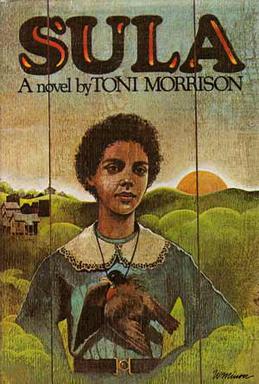 Sula
Sulaby Toni Morrison
reviewed by Ella Kitt
Toni Morrison’s 1973 novel, Sula, follows the lives of young Sula and Nel, two girls living the fictional, mostly black neighborhood, dubbed The Bottom. The girls’ personalities are heavily influenced by their families. As a result of Nel’s constrictive and traditional upbringing, she never gets the chance to truly experience being a child. She is micromanaged by her controlling mother, Helene, and grows up to mirror the consistency and quiet she once disdained as a child. By contrast, Sula’s household is loud and disorderly. As the titular protagonist, Sula’s unconventional upbringing molds her into an unorthodox young woman, eager to defy racial and gender norms. Her unwillingness to be subdued by society sets Sula up for a life constant conflict.
At first, it would appear that Sula and Nel act as simple literary foils but Morrison urges readers to consider the complex nature of human existence. Her masterful and intense descriptions of the characters’ inner processes brings her characters excitingly to life. Morrison’s haunting narration and vivid imagery create a unique setting for the novel that etches itself indelibly in the memory. She digs deeply and incisively into issues such as prejudice, materialism, and tradition.
As young black girls growing up in the 1920’s, Sula and Nel experience severe racism. Morrison evokes the oppression of African Americans with the powerful opening lines “in that place, where they tore the nightshade and blackberry patches from their roots to make room for the Medallion City Golf Course, there once was a neighborhood. It stood in the hills above the valley town of Medallion and spread all the way to the river. It is called the suburbs now, but when black people lived there it was called the Bottom” (Morrison, 1). Morrison deploys simple yet eloquent symbolism to kindle an emotional response from readers.
Sula and Nel are oppressed not only by racism but the expectations of women in a patriarchal society. From birth, they are taught that their only value is as wives and sexual objects. Morrison comments on the multifaceted intricacy of love and the repression of female sexuality. Ultimately, the opposing desires of the two characters lead them down the path of betrayal, crippling a once strong and genuine friendship.
I found this story to be especially relevant in an era where views on race and religion can be so polarizing. As humans, we have the tendency to label and categorize. Morrison challenges readers to fight this urge and always look for the other side of the story. She switches between the perspectives of different characters, forcing the reader to inhabit multiple viewpoints. I would recommend this novel to anyone as the way Morrison depicts seemingly simple characters in all their complexity makes it a compelling and stimulating read.
No comments:
Post a Comment